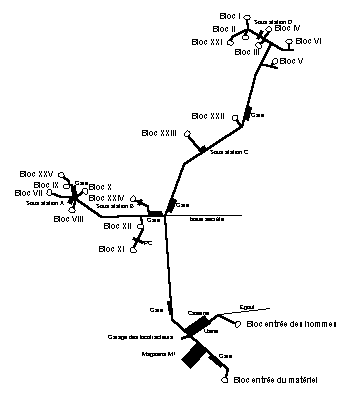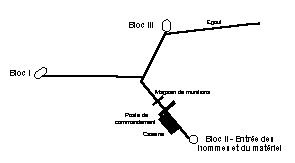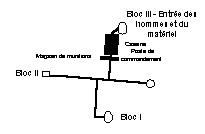Tourism on the Maginot Line
In spite of the hold of belated conscience by public instances about the fabulous
historic inheritance that are eastern fortifications, in spite of their abandonment
by the army that, moreover, often refuse to people motivated by their rehabilitation,
official access to sites, some associations yet persevered and succeeded in
restoring many forts.
The Hackenberg
The most powerful fort of the Maginot line which includes 19 blockhouses, 18 pieces of
artillery with a 1034 men crew belonging to the 153th RAP and 164th
RIF.
 Situated on the wooded crest of the Hackenberg that
culminates at 343 m high, the fort is divided in 2 ½ fortresses (east and west), which
are joined by a long underground tunnel equiped with a railroad track. These galleries
also join entrances situated on the other side of the hill and the indispensable
infrastructures to the life of a thousand men.
Situated on the wooded crest of the Hackenberg that
culminates at 343 m high, the fort is divided in 2 ½ fortresses (east and west), which
are joined by a long underground tunnel equiped with a railroad track. These galleries
also join entrances situated on the other side of the hill and the indispensable
infrastructures to the life of a thousand men.
After declaration of war, the fort is used by the propaganda as symbol of the Maginot
line. Personalities follow each other to visit the site, among them the king of England
and Winston Churchill.
After 9 months of inactivity, the Hackenberg wakes up June 18, 1940. Germans who occupy
Metz since the 17 progress toward the line taking the fort to reverse. The artillery of
the fort is used on June 22 to sustain the neighboring fort of the Michelsberg in prey to
a violent German attack. The crew puts down weapons on June 30 after the armistice and
goes to captivity.
Beginning 44, the Germans establish an underground factory in the munition storage M1
and in the underground barracks. This factory manufacturing pieces for the mechanical
industry is evacuated in August 44 with the threat of the allied advance.
In November 44, the progression of elements of the US 90th infantry-division
in direction of the wooded crest of the Hackenberg is stopped by a violent shooting of
dam. In a few minutes more of 60 deaths and injured strew soil. Shooting comes from the
VIII block where some Germans entrenched themselves. Americans make call to their heavy
artillery and the following day, a US self-propelled cannon of 155 mm makes tense
shootings on the occupied block, neutralizing one by one the 3 cannons of 75 mm served by
the Germans. These only deploring a killed, fold back, no without having blown up stocks
of weapons and present munitions in the storage room M1.
Restored in part by the Amifort-Veckring association, this fort is the most touristic one
of the Maginot line. Little trip on munition train, visit of the rich exhibition rooms
full of various weapons (armored vehicles, machine guns of all origins, rifles etc)
sometimes without big report with the fortification, pedestrian circuit joining the
different blocks by the outside. The Hackenberg is however "the fort" of the
Maginot line.
Arming : 3 cannons of 135 mm, 3 bomb-launchers of 135 mm, 4 mortars
of 81 mm, 9 cannons of 75 mm, 3 mortars of 50 mm, machine guns and light machine
guns of 7,5 mm.
Opened from the 1st of april to the 30th
of october on Saturdays and Sundays
Visits start from 2 PM to 3 PM
AMIFORT - Tourisme Information
FORT du HACKENBERG 61 bis, Grand'Rue 57920 VECKRING
( 03 82 82 30 08 FAX 03
82 82 32 77
The Simserhof
The Simserhof is the most powerful fort of Bitche area. It has been constructed between
1929 and 1933, but it was onlyt finished in 1938.
It includes 8 blockhouses, 2 entrance-blocks, 18 pieces of artillery and 6 anti-tank
cannons. Crew, is formed of 800 men taken from the 153rd RIF (light weapons),
the 150th RAP (artillery), the 1st RG (diesel motors and
electricity), the 15th RG (railroads) and the 18th RG
(transmissions).
One week before the declaration of the war, the place is operational.
During the "strange war" its activity limits itself to sporadic duels of
artillery against the German cannons situated on the other side of the border.

In May 40, the blitzkrieg explodes to the west, the French lines are driven. June 14,
40, Germans pierce through the Saar and attack forts of the Maginot line to reverse.
The Simserhof cannot prevent the fall of the Haut-Poirier and the Welschhoff, situated
out of range of its artillery.
On the other hand, with its guns, it reduces to nothing all tentative of attack enemy
against Rohrbach's fort. Close to 15 000 shells are pulled in 4 days.
After the armistice, the work is occupied by Germans who transform it in deposit of
munition.
They entrenche there in December 44; it will need to one week and the heavy weapons of
two American infantry divisions to dislodge them.
After the war, the French army restores the fortress and puts back it in state of working.
It will remain functional until the beginning of years 70. Now opened to the public, the
Simserhof's fort a very complete museum about the artillery of fortress.
Arming : 4 cannons of 135 mm, 4 cannons of 81 mm, 8 cannons of 75 mm,
4 cannons of 47 mm, 2 cannons of 37 mm, machine guns and light machine guns
of 7,5 mm.
The Michelsberg
A dynamic association, organized by French and German voluntaries
restore this fort.
You will be able to admire a middle class artillery fort while following explanations
of guides themselves implied in the restoration of this fortress.
They will make you part of their discoveries and will explain to you mechanisms
of all sytems (shooting, filtering of air...) which was adapted or invented to
make these forts modern citadels.
Opened all Sundays
of April to inclusive September
from 2 PM to 6 PM
and all year round on appointment
A.O.M. 6, rue du Docteur Schweitzer 57100 Thionville, ( 03 82 34 66 67
Fort Casso
(also called little ouvrage of Rohrbach)
 Foreseen initially like an artillery fort endowed with 8 combat
blocks (5 artillery blocks and 3 infantry blocks), of the budgetary restriction
fact, the fort only includes 3 infantery blocks constructed in 1935. The crew
of 166 men made part of the 166th RIF.
Foreseen initially like an artillery fort endowed with 8 combat
blocks (5 artillery blocks and 3 infantry blocks), of the budgetary restriction
fact, the fort only includes 3 infantery blocks constructed in 1935. The crew
of 166 men made part of the 166th RIF.
To counter the sudden German attack, on June 15 the fort makes shootings to support
fortifications situated on the west of the position (the Welschhof, and stand-alone
blockhouses).
The enemy comes closer and June 22 attacks the III block directly. The Germans make
direct shots to the machine gun and the cannon opening, but the artillery of the Simserhof
disperses attackers.
Germans renew their attack the 24, but, they must beat again in retirement when the
Simserhof opens fire. The fort's crew doesn't quit the fight that to the armistice.
Restored admirably by the association Fort Casso, the visit of this place is
very interesting because guides have very good knowledge concerning fortification.
All is explained (working of insiders hand grenade launchers, height of
kitchen sinks! ...)
Arming : 2 cannons of 47 mm, 3 cannons of 25 mm, machine guns and light machine
guns of 7,5 mm.
Visits start at 3 PM on Saturdays and Sundays 
Information : Town hall of Rohrabach 03 87 09 70 95
Access : Freeway A4 exit Sarreguemines to Bitche direction.
From Rohrbach, the itinerary is indicated.
The small ouvrage of Haut-Poirier
As Fort Casso, this small fort includes three infantery blocks. However the surface
occupied by the fortress is quite lower than the one of Rohrbach's fort.
 Excepted weapons and cables that made the fortune of scrap
merchants, most infrastructures are still inside this anbandonned fort : stove, troop
beds, air filters, various mechanical pieces...
Excepted weapons and cables that made the fortune of scrap
merchants, most infrastructures are still inside this anbandonned fort : stove, troop
beds, air filters, various mechanical pieces...
Defended by a crew belonging to the 166th RIF, the fort supports on June 21,
40, a German reverse attack. Out of range of the Simserhof's artillery, the fort can only
benefits on fort Casso's support. Bombarded by the thick Germans calibers cannons, it
capitulates the same day. Fights make 3 deaths on the French side.
Arming : anti-tank cannons of 47 mm, anti-tank cannons of 25 mm, machine
guns and light machine guns of 7,5 mm.
PC Head-quarters
RIF Infantry regiment of fortress
RAP Artillery regiment of position
RG Engineer regiment
The Galgenberg
(in construction)
The Maginot
Line on the web.
Many photos about the
Maginot Line.

Back
 Situated on the wooded crest of the Hackenberg that
culminates at 343 m high, the fort is divided in 2 ½ fortresses (east and west), which
are joined by a long underground tunnel equiped with a railroad track. These galleries
also join entrances situated on the other side of the hill and the indispensable
infrastructures to the life of a thousand men.
Situated on the wooded crest of the Hackenberg that
culminates at 343 m high, the fort is divided in 2 ½ fortresses (east and west), which
are joined by a long underground tunnel equiped with a railroad track. These galleries
also join entrances situated on the other side of the hill and the indispensable
infrastructures to the life of a thousand men. 
 Foreseen initially like an artillery fort endowed with 8 combat
blocks (5 artillery blocks and 3 infantry blocks), of the budgetary restriction
fact, the fort only includes 3 infantery blocks constructed in 1935. The crew
of 166 men made part of the 166th RIF.
Foreseen initially like an artillery fort endowed with 8 combat
blocks (5 artillery blocks and 3 infantry blocks), of the budgetary restriction
fact, the fort only includes 3 infantery blocks constructed in 1935. The crew
of 166 men made part of the 166th RIF. 
 Excepted weapons and cables that made the fortune of scrap
merchants, most infrastructures are still inside this anbandonned fort : stove, troop
beds, air filters, various mechanical pieces...
Excepted weapons and cables that made the fortune of scrap
merchants, most infrastructures are still inside this anbandonned fort : stove, troop
beds, air filters, various mechanical pieces... 